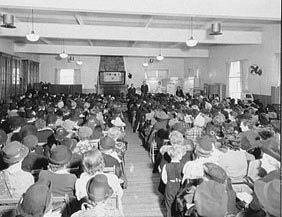Marketing Electricity for the Home

In the early days of electricity, few people had anything other than electric lights. The most popular appliances were electric fans and electric irons. Most people didn’t have the money—or inclination—to bring other electric gadgets into the home. This left appliance makers with the marketing task of convincing people that they needed the wide range of appliances that almost all of us use today. Simply making these appliances available was not enough and neither was advertising them. Selling people on the use of electricity in the home required manufacturers to go directly to the people.
One of the ways that they did this in the early years was to set up and demonstrate their wares at the great fairs. While these fairs are not common today, in the late 19th and early
20th century, countries, states (in the U.S.), and even counties or cities would hold elaborate fairs where art, culture, and science were on display to the public. They were a bit like amusement parks, where one paid an entrance fee and walked from exhibit to exhibit. For example, at the Panama-Pacific Exposition in San Francisco in 1915 (which celebrated the opening of the Panama Canal), appliance manufacturers demonstrated their latest products to the crowds visiting the huge “home economics” building.
In later years, from the 1930s to the 1960s, appliance manufacturers became even more direct. They took their demonstrations on the road, visiting local towns and neighborhoods. This was particularly important in the case of kitchen appliances. Electric stoves, ranges, and various appliances were shown to women at heavily advertised demonstrations held in schools, public halls, or tents. In the U.S., appliance manufacturers also struck deals with the local power companies to put displays of appliances in the thousands of community collection offices. When people came into the office to pay their bills (as was the custom years ago), they would walk past the latest lineup of gadgets. It proved to be a very effective way of selling.